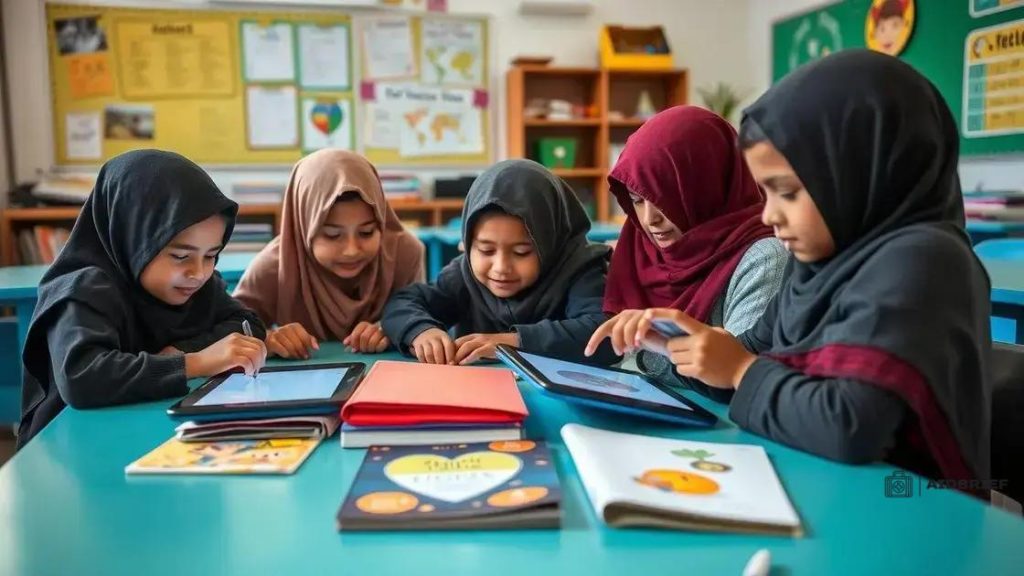Adaptive e-learning for refugee students: effective strategies

Adaptive e-learning for refugee students tailors educational experiences to individual needs, leveraging technology and community support to overcome barriers and enhance engagement, leading to successful academic outcomes.
Adaptive e-learning for refugee students is reshaping how we address educational needs in resettlement programs. With diverse backgrounds and varying skill levels, understanding how to tailor learning can make all the difference. So, how can we implement effective strategies?
Understanding adaptive e-learning principles
Understanding adaptive e-learning principles is crucial for supporting refugee students in their educational journeys. This approach tailors the learning experience to meet individual needs, enhancing engagement and effectiveness.
Adaptive e-learning utilizes technology to adjust content based on students’ performance and preferences. This dynamic method not only facilitates personalized learning but also promotes self-paced education.
Key Components of Adaptive E-Learning
There are several essential elements that contribute to the success of adaptive e-learning.
- Personalization: Education is tailored to fit the unique strengths and weaknesses of each student.
- Data-Driven Insights: Continuous assessment allows educators to track progress and modify content as needed.
- Flexibility: Students can learn at their own pace, giving them the ability to revisit concepts and materials.
- Engagement: Interactive elements keep students motivated and involved in their learning process.
Implementing these principles requires careful planning and training. Educators must first understand the specific needs of refugee students. By creating supportive environments and encouraging a growth mindset, educators can foster resilience and adaptability.
Moreover, utilizing technology effectively is key. Tools like learning management systems can provide valuable resources and support. In particular, incorporating multimedia elements can enhance comprehension and retention. It’s important to ensure that all material is accessible, as refugees may face challenges such as language barriers or limited prior education.
Ultimately, the goal of understanding adaptive e-learning principles is to create responsive educational systems that meet the diverse needs of refugee students. By embracing these strategies, educators can significantly improve learning outcomes and help students thrive in their new environments.
Key challenges faced by refugee students
Refugee students face many unique challenges that can impact their learning process. These obstacles must be understood and addressed in order to create a supportive educational environment. The challenges often stem from cultural differences, language barriers, and trauma.
Cultural Adjustments
One major challenge for refugee students is adjusting to a new culture. They often experience significant changes in their everyday life, which can lead to feelings of isolation. Many refugee students come from different educational systems and may struggle to adapt to the expectations of their new schools.
Language Barriers
Language is another critical barrier. Many refugee students may not speak English fluently, making communication difficult. This can hinder their ability to engage with peers, follow lessons, and seek help when needed.
- Limited Vocabulary: Refugee students may only know basic English words.
- Complex Instruction: Understanding teachers’ instructions can be problematic.
- Social Interaction: Making friends can be tough due to language differences.
In addition, trauma from their past experiences can greatly affect their learning. Many refugee students arrive with unresolved emotional issues that lead to difficulties in concentration and participation. It’s essential for educators to recognize these challenges and create a nurturing atmosphere.
Support systems play a vital role in helping refugee students overcome these hurdles. Schools can implement mentoring programs or provide language classes to aid in their adjustment. By fostering relationships and establishing a caring community, we can significantly improve the educational experience for these students.
Best practices for engagement in e-learning

Engaging refugee students in e-learning is crucial for their academic success. Implementing best practices can enhance their motivation and participation in the learning process. It is essential to create a welcoming and interactive online environment that encourages involvement.
Interactive Content
One effective way to engage students is by incorporating interactive content. Activities that require active participation can keep students interested. For example, using quizzes, discussion boards, and simulations can make learning fun and engaging.
- Gamification: Adding game-like elements can motivate students to complete tasks.
- Multimedia: Videos and audio materials cater to different learning styles.
- Peer Collaboration: Group projects can foster teamwork and communication.
Creating a supportive classroom culture is another important aspect. When refugee students feel safe and valued, they are more likely to engage. Teachers should encourage open communication and make themselves available for questions and support.
Personalized Learning Paths
Every student learns differently, so offering personalized learning paths is key. Allowing students to progress at their own pace can help reduce anxiety and build confidence. Providing choices in assignments can also give them ownership of their learning experience.
Frequent feedback is vital in maintaining student engagement. Regular check-ins help students understand their progress and areas for improvement. Recognizing their achievements, no matter how small, can boost their motivation.
By implementing these best practices for engagement in e-learning, educators can create a positive learning experience for refugee students. It’s all about making learning accessible, enjoyable, and relevant to their lives.
Technological tools that aid learning
Technological tools play a vital role in enhancing learning experiences for refugee students. By integrating these tools into education, we can create more engaging and accessible learning environments. Some of the most effective tools offer flexibility, interactivity, and personalized learning opportunities.
Learning Management Systems
Learning Management Systems (LMS) provide a centralized platform for students to access educational resources. These systems allow teachers to upload materials, track student progress, and communicate effectively.
- Accessibility: Students can access resources anytime and anywhere.
- Progress Tracking: Teachers can monitor individual student performance easily.
- Communication Tools: LMS often include chat and forum features for collaboration.
Additionally, educational apps and platforms can significantly aid in the learning process. These apps often cater to various subjects and skills, offering exercises and tutorials that adapt to the user’s level.
Language Learning Tools
Language learning tools are particularly beneficial for refugee students who may be acquiring a new language. Programs like Duolingo and Rosetta Stone provide engaging ways to practice vocabulary and grammar. These tools are designed with gamification elements that make learning fun and less daunting.
Moreover, interactive websites and online courses allow students to learn at their own pace. Videos, quizzes, and games enhance learning by making it more enjoyable. These resources can help bridge the gap caused by language barriers and provide tailored support based on individual needs.
Incorporating technological tools into the curriculum not only motivates students but also enhances their academic performance. By leveraging these resources, educators can create a more inclusive and effective learning environment for refugee students.
Success stories from U.S. resettlement programs
Success stories from U.S. resettlement programs illustrate the positive impact of adaptive e-learning on refugee students. These stories showcase how tailored educational approaches can help students thrive in their new environments.
Case Study: A Refugee Student’s Journey
For instance, consider the journey of Ahmed, a refugee from Syria. Upon arriving in the U.S., Ahmed faced significant language barriers and cultural adjustments. However, with the support of an adaptive e-learning program, he received personalized instruction tailored to his needs.
- Language Support: The program included language learning tools that helped him gain proficiency in English.
- Mentor Guidance: A dedicated mentor provided one-on-one support, fostering a sense of belonging.
- Community Engagement: Ahmed participated in community activities that reinforced his learning and social integration.
Over time, Ahmed improved academically and socially, eventually excelling in his studies and gaining acceptance into a local university. His story is just one of many that highlight the essential role of adapted educational practices.
Programs Making a Difference
Numerous resettlement programs across the U.S. have adopted similar approaches to support refugee students, leading to remarkable outcomes. For example:
- Partnerships with Local Schools: Many organizations collaborate with schools to provide additional resources and training for teachers.
- Interactive Learning Environments: Programs use technology to create engaging and interactive learning experiences.
- Family Involvement: Efforts to involve families in the educational process have shown positive effects on student success.
These initiatives demonstrate that with the right tools and support systems, refugee students can overcome obstacles and achieve their goals. By sharing these success stories, we can inspire further developments in adaptive e-learning strategies, ensuring that all students have the chance to succeed.
In conclusion, adaptive e-learning has the potential to transform the educational experience for refugee students. When implemented effectively, it addresses their unique challenges and encourages their personal and academic growth. By utilizing technological tools, personalized learning paths, and community support, we can create environments where refugee students thrive. Success stories highlight the importance of these approaches, reminding us that with the right resources and strategies, every student can achieve their dreams.
FAQ – Frequently Asked Questions about Adaptive E-Learning for Refugee Students
What is adaptive e-learning?
Adaptive e-learning tailors educational content to meet the individual needs of students, especially beneficial for those with diverse backgrounds.
How can technology support refugee students?
Technology provides accessible resources, interactive content, and personalized learning pathways, helping refugee students engage and succeed.
What are some challenges faced by refugee students in e-learning?
Refugee students may encounter language barriers, cultural adjustments, and emotional trauma that impact their learning experience.
How can community involvement enhance learning outcomes?
Community involvement fosters a supportive environment, providing resources and encouragement that help refugee students thrive in their education.





